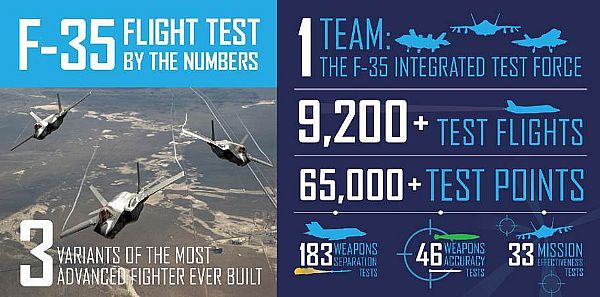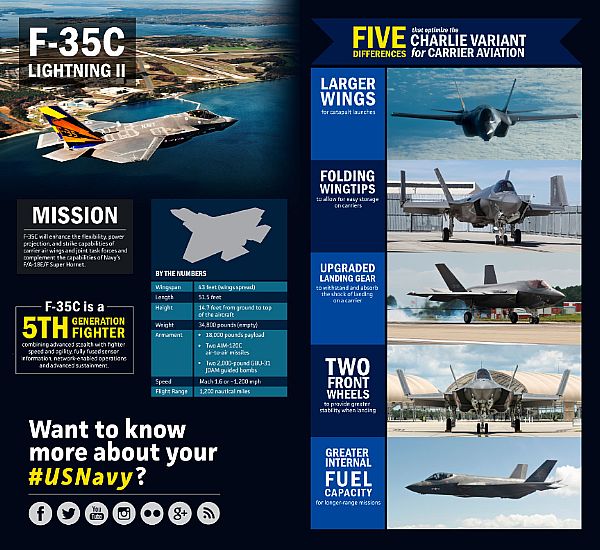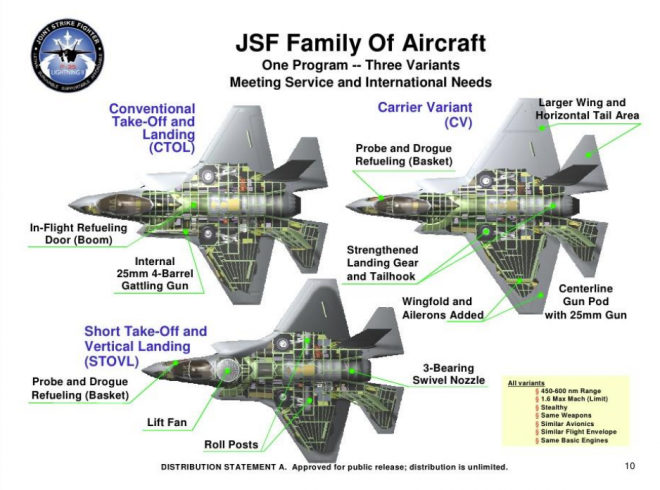Lockheed Martin
Lockheed Martin
- ロッキード・マーチン社/ノースロップ・グラマン社/BAEシステムズ社製 初飛行:2000年10月24日(X-35A) F-35Bデータ=全幅:10.66m(C型は13.10m) 全長:15.59m(C型は15.67m) 全高:4.34m(C型は4.44m) 翼面積:42.73m²(C型は62.05m²) 空虚運用重量:14,651kg(C型は15,785kg) 最大離陸重量:27,215kg(C型は31,751kg) パワープラント:アフターバーナー使用時定格推力191.35kNのプラット&ホイットニー製F135-PW-400推力偏向式排気口付きターボファン・エンジン1基(C型)、垂直離着陸時180.8kN(ロールスロイス製揚力ファンにより83.1kN、主エンジンのロールスロイス製推力偏向排気口により83.1kN、主翼付け根部2ヶ所のリアクション制御排気口により14.6kN)のプラット&ホイットニー製F135-PW-600ターボファン・エンジン1基(B型) 制限マッハ数:1.6 実用上昇限度:15,240m(Block 3F) フェリー航続距離:1,666km(C型は2,222km) 戦闘行動半径:833km(C型は1,111km) 兵装:機関砲:GAU-22/A 25mm回転式機関砲1門(A型のみ、B型、C型は取り外し式機関砲ポッド) 投棄可能兵装:機内搭載にはAIM-120 AMRAAM2発、1,000lb(453kg)GBU-31または2,000lb(907kg)GBU-32 JDAM2発を含む 乗員:1名 ユニット・コスト:$104,000,000(F-35B、低率量産)、$116,000,000(F-35C、低率量産)
- ※社内呼称モデル700(L-700)
- ※1996年頃に統合攻撃戦闘機(Joint Strike Fighter)計画が誕生し、1996年11月16日に概念実証計画(CDP)に進む担当会社として、ボーイング・チームとロッキード・マーチン・チームが選ばれた。計画機名称は、ボーイング・チームにはX-32、ロッキード・マーチン・チームにはX-35が与えられる。2001年10月26日にロッキード・マーチン・チームが勝者に選定され、次のシステム開発及び実証(SDD)段階(これまでは技術、製造、開発(EMD)と呼ばれていた)に進むことになった。そして、X-35からF-35に制式名称を改めた
- ※X-35の初期構成は1997年中期に確定した仕様220と呼ばれるものであったが、最終的なJSF設計(仕様230)に至るまでさらに変更が加えられた。提示されている基本型は、X-35A(アメリカ空軍向けの通常離着陸(CTOL)仕様機)、X-35B(アメリカ海兵隊およびイギリス海/空軍向けの短距離離陸垂直着陸(STOVL)仕様機)、X-35C(アメリカ海軍の艦載(CV)運用仕様機)の3種類
- ※X-35Bの後方排気ノズルは、ロシアのYak-141でも採用された3BSN(3 Bearing Swivel Nozzle)と呼ばれる技術データが提供されるもすでにアメリカ海軍でも1970年にコンヴェア社(後のジェネラル・ダイナミックス社)で、超音速STOVL機の設計として研究されたこともあるものでX-35Bに導入済み
- ※国防総省は、2006年7月7日にF-35の公式愛称をライトニングII Lightning IIと命名
- ※F-35Cが米海軍のどの空母にも配備できるようになるために必要なこと:
F-35A/B/Cは全て、デジタル・ネットワーク化された整備システムで運用されている。このシステムはODIN(Operational Data Integrated Network)と呼ばれている。ODINは略称で言えば既に3代目であり、これまでに12以上のメジャー・ヴァージョンが存在している。ODINは基本的に、整備士に機体の整備内容を正確に示す計画・診断ツール。計画整備、定常整備、予防整備、是正整備、緊急整備など、あらゆる整備において、このシステムが稼働している必要がある。
空母航空団 Carrier Air WingsでF-35Cを運用する飛行隊と、空母に駐留する航空機中間整備部門 (Aircraft Intermediate Maintenance Departments: AIMD) には、飛行甲板、格納庫、整備作業センターにODINに接続できるハードウェア、ソフトウェア、インフラストラクチャが必要。
ジェット機の整備には、飛行隊とAIMDには全く異なる身体能力が必要。エンジンには特別なシステムが必要で、機体外板にも特別なシステムが必要。
ネットワーク自体には、機密区分情報施設(Sensitive Compartmented Information Facility: SCIF)における最高機密データの入力//アクセスを含む機密ワークステーションが必要。また、世界との安全な通信プラグイン、つまり独自のアンテナとトランシーヴァーも必要



Update 25/10/20